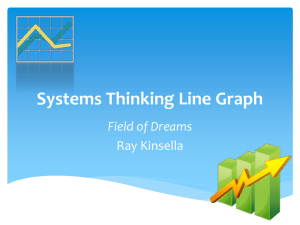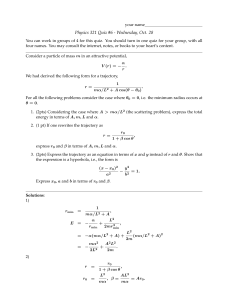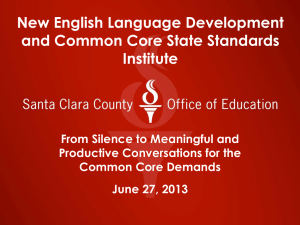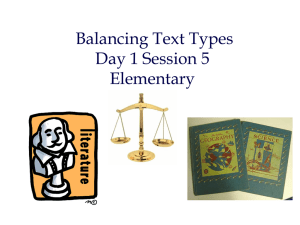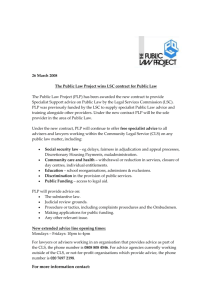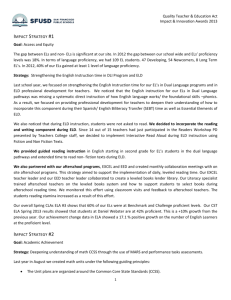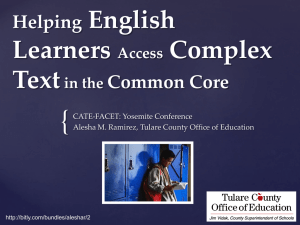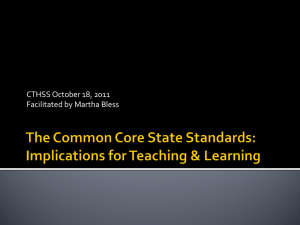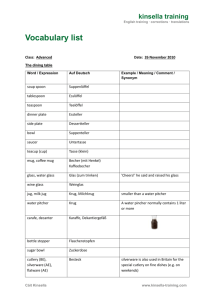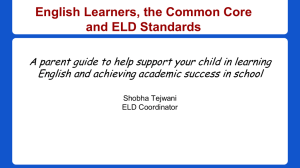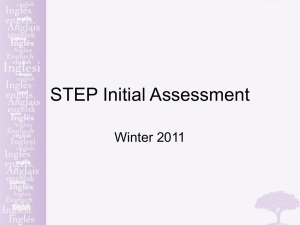Eve Lindsay B I
advertisement
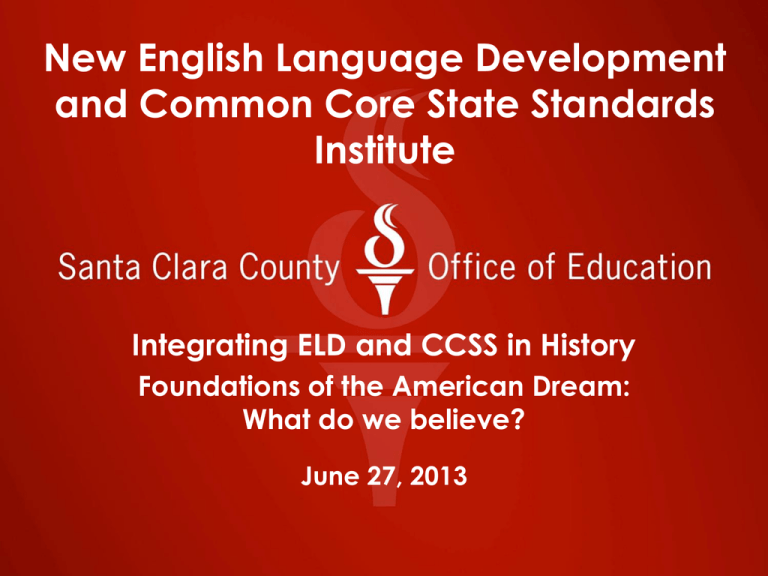
New English Language Development and Common Core State Standards Institute Integrating ELD and CCSS in History Foundations of the American Dream: What do we believe? June 27, 2013 Introductions Eve Lindsay Literacy Coach, TOSA Campbell Union School District • I was a 7th grade English, social studies, and ELD teacher for 7 years • I have been an instructional coach for the past 3 years, focusing on helping teachers support ELs • You work in a variety of settings and contexts—I hope you can find something in the lesson or presentation that can help you or your students in your context. 2 Norms • Standard etiquette – cell phones – me/we questions – side conversations • 7 Ps – pause, paraphrase, probe, presume positivity, put on the table, pull off the table, pay attention, pursue a balance • Focus on what we can control, set aside what we cannot 3 Goal Prepare every English Learner for college and career success! 4 Objectives • Practice close reading strategies with a complex text • Practice integrating reading strategies and PLP throughout a content lesson • Discuss strategies that support English Learners 5 Glossary • BBK: build background knowledge • CFU: check for understanding • GLAD: Guided Language Acquisition by Design • KK: Kate Kinsella • LWF: Lily Wong Fillmore • PIC: Pictorial Input Chart • PLP: Planned Language Production • UL: Understanding Language (Stanford U.) 6 Foundations of the American Dream • Key standards: CA History, CCSS Literacy, CA ELD Part 1 • Big Idea: Understand how the U.S. government struggles to balance multiple concerns • Essential Question: To what degree has America successfully balanced the ideals and structures outlined in the founding documents? • Summative Assessment: persuasive speech proposing solutions for national controversies 7 The Class • This lesson has not been student-tested, but it was created with a specific class in mind • 11th grade, 41 students • estimated 80-90% SED • estimated 70% ELs, 90% LM • estimated 75% reading below grade level 8 Resources • Kinsella, Kate, Ed.D. Instructional Tools to Prepare English Learners for the CCSS Academic Discourse Demands. SCCOE, 2012. • Daniels, Harvey and Nancy Steineke. Texts and Lessons for Content-Area Reading. Heinemann, 2011. • The Constitution of the United States: A Transcription – http://www.archives.gov/exhibits/charters/ constitution_transcript.html 9 Model Lesson • Teacher-led close reading of complex text • Modeled Think Aloud • Attention to citing evidence and supporting opinions • Prepare students to grapple with text for deep understanding • PLP 50% of lesson • Note-taking template • Highly integrated with Literacy and ELD standards 10 Model Lesson • Teacher-led close reading of complex text • Modeled Think Aloud • Attention to citing evidence and supporting opinions • Prepare students to grapple with text for deep understanding • PLP 50% of lesson • Note-taking template • Highly integrated with Literacy and ELD Part 1 standards 11 Text Complexity • It’s more than a number/grade level/lexile • Per Lily Wong Fillmore: “Complex texts are necessary because – such texts provide access to information and ways to gain knowledge of subject matter that can be learned only through close and thoughtful reading of complex texts. – students must get two things from their K-12 experience: knowledge of the many phenomena we expect people to know about, and the development of complex reasoning and thought. – literacy of the type promoted by the CCSS is essential to the development of both.” 12 Three Factors to Measure Text Complexity Reader and Task 13 Into the Lesson • Try to view from two lenses—first as an 11th grade student, then as an 11th grade history teacher 14 Into the Text (student) • What words challenge you? • What sentences challenge you or don’t make sense? • What else do you need before you feel comfortable attempting to read this text without the teacher? 15 Into the Text (teacher) • How can you most effectively help students learn vocabulary? • How do you deconstruct the grammar and syntax to support student understanding? • How can you support your ELs in accessing this text while still maintaining rigor? 16 Talking Stick—Final Word • First person: Share your thoughts from the previous slide and pass the stick • Each other person: Respond to #1’s thoughts and pass stick • First Person: Any further explanation of thoughts or response to other participants • Repeat process with second person • Be prepared to share with whole group 17 Support Your Position • CCSS call for students to use evidence from the text in discussions • Requiring students to choose a position, discuss it, and find evidence to support it taps at least 3 “Cs”: Critical Thinking, Collaboration, and Communication • “Students must be able to ‘cite textual evidence to support analysis of what the text says explicitly as well as inferences from the text.’” Texts and Lessons for Content-Area Reading, p. 78 18 Essential Components for LTELs • • • • • • • • • • Oral language Student engagement Academic language Expository text (reading and writing) plus other genres Consistent routines Goal setting Empowering pedagogy Rigor Community and relationships Study skills 19 Other Valuable Strategies for ELs • Dr. Kinsella’s routines for learning academic vocabulary • Dr. Fillmore’s academically productive conversations • Understanding Language example of the Gettysburg Address • PLP woven throughout, 50% of the lesson • Gradual Release • “Juicy” sentences • Your suggestions? 20 Planned Language Production • Output – “miles on the tongue”/fluency – practicing correct speech – not necessarily authentic or deep • Interaction – audience-dependent – may be incorrect, but more authentic – simulates career situations 21 Seeds for future lessons • Further class time devoted to investigation, discussion, note-taking • Continue to support students in small groups • Mini-lessons on collaboration and critical thinking skills • Continue to require academic conversations throughout the research process • Revisit Constitution for “juicy sentences” to dissect and emulate when preparing to write research report 22 Further resources • Investigate Dr. Kinsella’s handouts on SCCOE website – http://www.sccoe.org/depts/ell/kinsella.asp – http://www.sccoe.org/depts/ell/kinsella.aspx • Investigate Dr. Fillmore’s handout and video – http://vimeo.com/47315992 • Investigate Understanding Language unit – http://ell.stanford.edu/teaching_resources/ela • Investigate possible rubrics for the 4 Cs – http://www.bie.org/tools/freebies 23 Closing • Review objectives – Practice close reading strategies with a complex text – Practice integrating reading strategies and PLP throughout a content lesson – Discuss strategies that support English Learners • Questions? 24

